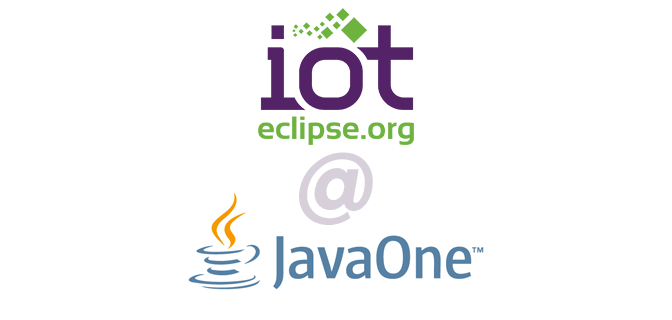If you are attending JavaOne this week, I want to make sure you don’t miss out on the many opportunities to learn more about Eclipse IoT, and meet the people behind it.
Eclipse Foundation booth
You can find us at the Eclipse Foundation booth (#5710). There will be several IoT demos all week long, so it’s probably your best chance to learn about Eclipse IoT and meet the people behind our projects. There will also be an exciting announcement at the beginning of the week so you may want to drop by to learn more! 🙂
Tutorials
We’ll start the week with a CoAP tutorial that should be pretty fun, and an opportunity for you to learn more about this interesting IoT protocol.
- Connecting Everything with CoAP [TUT5637] – Benjamin Cabé, Eclipse Foundation
Monday, Oct 26, 8:30 a.m. | Hilton—Continental Ballroom 7/8/9
Conference sessions
There are lots of Eclipse IoT related talks this year, so please make sure your agenda is up-to-date if you want to learn more about Kura, SmartHome, MQTT, and much more…
- End-to-End IoT Solutions with Java and Eclipse IoT Technology [CON5624] – Benjamin Cabé, Eclipse Foundation
Monday, Oct 26, 2:30 p.m. | Hilton—Continental Ballroom 6 - Taming the Nashorn to Rule the Smart Home [CON5375] – Kai Kreuzer, Deutsche Telekom
Monday, Oct 26, 12:30 p.m. | Hilton—Continental Ballroom 7/8/9 - Security for Java-Based IoT Gateways [CON5364] – Marco Carrer & Luca Dazi, Eurotech
Tuesday, Oct 27, 12:30 p.m. | Hilton—Continental Ballroom 6 - Plugging Configurability into Your IoT Application Gateway [CON4441] – Marco Carrer, Eurotech & Frank Alexander Kramer, bitreactive
Tuesday, Oct 27, 2:30 p.m. | Hilton—Continental Ballroom 6 - Visualize Your IoT in the Cloud (with Flying Drones) [CON2087] – Ville Ingman, Vaadin
Tuesday, Oct 27, 4:00 p.m. | Hilton—Continental Ballroom 7/8/9
I hope to see many of you at the conference, please ping me if you want to have a chat!

